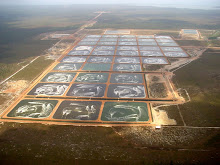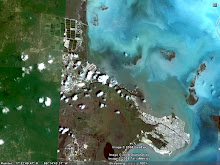http://i710.photobucket.com/albums/ww101/theodore1800/design1v1.jpg
 It has many positive qualities and works as an excellent starting point (thanks, Liz!)
It has many positive qualities and works as an excellent starting point (thanks, Liz!)
Main Structure.
Working from this design, I created a similar structure. This design consists of a less sturdy structure, as I use the PVC piping primarily to keep the aquamats from moving and to allow for easy removal of aquamats for replacement. According to http://www.nurturetech.net/aqua.htm, aquamats are equipped with ballast bags to keep them in place, but the PVC structure could allow several aquamats to be removed from the pond at the same time. This structure, consisting of a primary pipe paralleling the side of the effluent canal and perpendicular secondary pipes that the aquamats slip over, is attached to bank of the canal by ropes. One end of a rope would be tied to the primary pipe, and the other end would be tied on a stake on the side of the canal. This means the entire structure can be removed.
Details.
Each unit stemming from the primary pipe is connected by a tee and consists of one PVC pipe, one aquamat, and one cap. The PVC pipe length is slightly longer than the top of the aquamat. For the present, my idea for attaching the aquamat to the pipe would be to fold the top over to create a tunnel. I still need to work out exactly how this could be done, one option would be to sew this pocket in the aquamat; another option would be to use some kind of adhesive or pin to secure this tunnel. The aquamat would be kept from sliding off the PVC pipe by the cap. The top of each unit will be roughly equal to the surface of the water because of the floatation element associated with the aquamat.
Removal of substrate.
This design offers several different options for removal of organisms. I will briefly outline a few of them (discussed in our latest inventor’s club), and eventually follow up with more details.
1. Remove the entire structure and place in shrimp pond. Pros: this way we can utilize organisms growing both on the aquamats and the primary pipe. Cons: time must be allowed for the shrimp to eat off the structure
2. Remove entire structure and strip organisms by hose or rake. Pros: allows for faster cycle than in option 1. Cons: labor
3. Remove aquamats only and strip organisms by hose or rake.
4. (Inspired by Mr. Smith) Leave entire structure in the water, and move down the middle of the canal scraping all of the aquamats in sort of one swoop (this would only work with careful spacing of the aquamats, and we would have to develop a way to collect the substrates in the water). Pros: quick and dirty, Cons: we need to look into this further to be more specific. Hard to describe, so included a brief video demo- the spatula with basket represents the scraper tool (more on that later), the sticky notes are aquamats.
Pictures
Apologies for the strange model. PVC pipes represented by chopsticks, caps by pencil toppers, aquamats by cut paper, water by blue towel, rope by red yarn, PVC tees by masking tape.
http://i710.photobucket.com/albums/ww101/theodore1800/design1v2.jpg


http://i710.photobucket.com/albums/ww101/theodore1800/Overview.jpg






We need to consider how heavy the entire design will be, and imagine trying to lift the design + all the water-logged growth on it. Your design is less weighty than mine, because it has less PVC pipe, but something I think we need to discuss.
ReplyDeleteFor a cap: I was thinking of a similar thing, but when I was looking around in the hardware store, the actual PVC caps are tiny, and would not hold the Aquamat in place. We would have to come up with something else - I was actually thinking that maybe we could use a T PVC joint, so that it creates a
|===
where | is the top part of the T, and the === is the piping. (I hope that made sense!)
It might successfully blockade the Aquamat's tunnel from coming off.
One thing I am worried about generally, is that if you tried to remove the growth in the water, would it start dissolving as soon as you scraped it off?
Also, the final design on the bottom you show looks good, I think that it is much lighter, and probably easier to deal with. It could be allow the dangling material from the PVC to be very long, which makes the ratio of the cost of making one of these to the amount able to be removed good. Let me think on this one, and I'll get back to some other issues.
The design is evolving nicely!
ReplyDeleteECrussel, the scraping in the water issue is a valid one, and Allen is also correct that the weight of the AquaMats will be substantial when they are weighted down with water. That weight will be substantial at first, then much less after a mat is lifted and the water drains out.
The scraping issue is looming out there to be delt with. There are some clear questions:
1. Will the shrimp eat and grow on "scraped" periphyton and the subsequent biota it produces (it is reasonable to assume they will, but we haven't tried this yet so we don't know...hopefully I can find out how this works during this trip).
2. What instrument/device would you use to scrape the mats?
3. Will the mats stand up to repeated scraping (I think yes, but we can't go nuts during the scraping process).
4. How would you collect the scraped slurry?
5. How would you transport the slurry over the berm into the shrimp pond?
Addressing:
ReplyDeleteCap.
I was actually thinking that last night when creating the design, since there are several options. I agree that PVC caps aren't sufficient for keeping the aquamats in place, so a T with a male perpendicular element could probably do the trick. I'm making a trip to the hardware store and will investigate further.
Weight.
Definitely going to be an issue. This will determine how many units we can chain together as well as whether or not removal of the structure will be practical. Could anybody supply the dimensions of the aquamats? Conducting a quick-and-dirty google search, I found some 3' tall, 6'5" model at http://www.aquamats.com/AquaMats-2005-Model-24020-R3.pdf, but not much more useful information.
The slurry collection question.
I was most intrigued by your idea of rolling down the canal in a boat or on foot, scraping the mats in the process. To make this work, we would have to design some sort of tool that could simultaneously scrape aquamats and collect materials. This poses a significant challenge, especially given our limited resources. I'll post a visual of this soon, along with some more specific numbers and proposals for the tool.
Love the video!
ReplyDeleteFor the design of AquaMat that currently exists, that would be an excellent way to deal with a fast-pass scraping.
We should think too about new designs of AquaMat (and possibly other materials) that would be ammenable to rapid harvest. How do we jam the most possible harvestable area into the smallest possible space and still keep enough light on the surfaces to encourage algae growth?
I love the video too! I think that you might be able to attach that to a boat, I'll try to make a design tonight and post it tonight.
ReplyDeleteYour design looks really good. However, it seems that you have attached the rows of AquaMats together on the side. Would this be a free standing structure or would it be attached to the bank? Also, are we going to be encountering problems of maneuvering in the canals if we put too many of these structures in the water, considering their width?
ReplyDeleteTo Mr.Smith:
While we are considering using boats to scrape the AquaMats, do we need to add those in to our cost or can we assume that they are preexisting and that getting one or two would not be much of a problem?
Addressing Liz's question about the goo dissolving in the water, what if we built some sort of simple structure on the boats (assuming that they will be a viable option) that will scrape the goo off and directly into the boat? A little more planning is obviously need but this would solve multiple problems:
1)Fewer people would be needed to manage the job as there would no longer be a need to specifically delegate a person to scraping the goo off.
2)In theory, this would probably be a less clean/complete scraping process, leaving some of the goo remaining on the AquaMats or whatever substrate we would be using, and hopefully maintain the living organisms that are growing on the substrates at a relatively maximum growth stage.
3)This would possibly speed up the process.
However, having done a little bit of rowing, I know that if there is a counteracting force on one end of the boat, the boat tends to go in a more side wise direction, which would prove to be a problem.
Also, you do run into the problem that we're assuming that we're going to be getting buckets of this goo. How would we then feed the shrimp, considering that we probably want to evenly distribute the feed over the entire pond. I'm not sure how they currently feed the shrimp. Do they do it by hand or is there some machine that they use that may also be useful in our distributing of the nutrients that we get out of the water?
Good comments, Amy.
ReplyDelete1. Yes, the boat is an expense. They have them already, but they can't use them for other purposes while they are in the canals.
2. I think the manouverability/guiding issue can be addressed by the spacing of the PVC pipes or posts. With a tether on the front of the boat to pull it along, the posts can keep the boat in place by pushing on the sides.
3. The scraper is indeed an important part of the design. Keep in mind that in the short term, the experiments I will do will only look at biomass accumulation, and the scraping will require some experiments of its' own. A couple of issues to keep in mind are that the Aquamats will be heavy with water during the first few seconds they are raised from the water. They need to drain a bit before we scrape them or the slurry will have excessive water weight.
4. As for handling the "goo" (or slurry), that is a good item to think about. For now, the most obvious options are to use a pump or to carry the slurry in buckets up to the pond. It should disperse somewhat on it's own, but the idea of spreading it out makes sense as well.
By the way, I am in Belize now and have a good internet connection (I think). I can stay in touch with the process and begin working soon (I have a couple of permits to get first).
Very handy product. I used it & loved it. Thanks.
ReplyDeleteBathmate